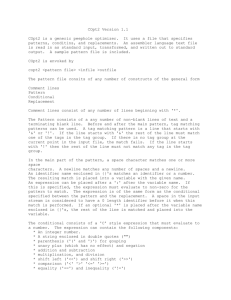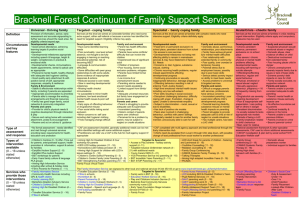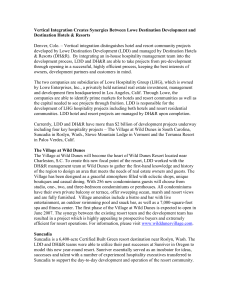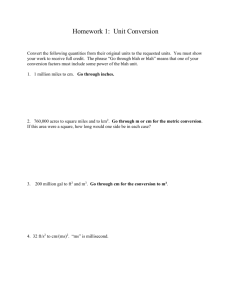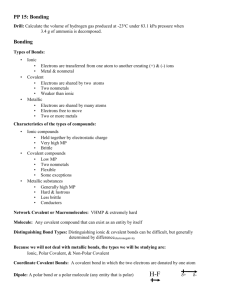7. Acceptable LDD Ratios
advertisement
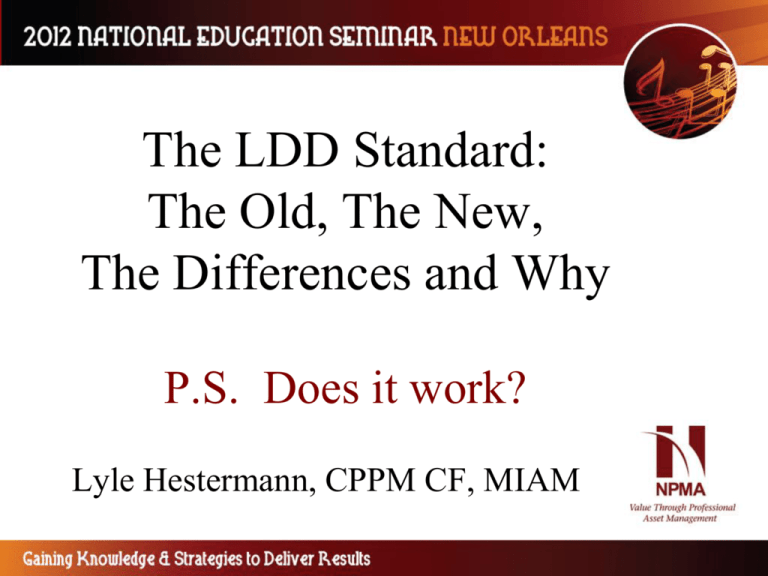
The LDD Standard: The Old, The New, The Differences and Why P.S. Does it work? Lyle Hestermann, CPPM CF, MIAM Why An LDD Standard? Common sense says: • LDD is a key indicator of the effectiveness of a property management system • The better the property control system, the lower the amount of LDD. • Less LDD = better asset management = – – – • fewer acquisitions more efficient utilization Better disposition process LDD is thus a key datum of risk management. Why An LDD Standard? However, • Lack of published, consistent policies and standards about asset management So • NPMA teamed with ASTM International for VCSs, that will gauge the effectiveness of policy and procedure implementation E2131, Old vs New Original edition approved Jan. 10, 2001. Published February 2001. Current edition approved Sept. 1, 2009. Published October 2009. The Old, The New – The Title Standard Practice for Assessing Loss, Damage, or Destruction of Property Standard Practice for Addressing and Reporting Loss, Damage, or Destruction of Tangible Property 1. Scope 1.1 This practice covers the assessment of loss, damage, and destruction (LDD) of property, assets, or material. LDD occurs when such property is found to be missing, damaged, or destroyed. Such discoveries often are made as a result of a Physical inventory, an analysis of material used, or routine audits. 1.1 This practice focuses on addressing and reporting loss, damage, or destruction (LDD) of tangible property. 1.3 LDD events are often discovered as a result of a physical inventory or other audit. An actual LDD event can occur at any time during the property life cycle. 1. Scope 1.2 Some occurrences of damage and destruction are the result of natural disasters or other incidents beyond the control of the company, agency, or institution, and are not subject to the standards in paragraph 7. However, the reporting of such instances in accordance with paragraph 8 is still required. 1.4 LDD events resulting from natural disasters or other incidents beyond the control of an entity are not subject to the criteria in 1.7. Reporting LDD events is required. 1. Scope 1.3 Some occurrences of LDD are a result of natural degradation or other incidents of fair wear and tear and are not addressed as a part of this practice. 1.5 Natural degradation or normal wear and tear are not considered LDD events and are not addressed in this practice (they may, however, be considered in establishing residual value). 1. Scope 1.4 Loss, damage and destruction, while three completely different occurrences, are addressed as one in this standard. For the purpose of this standard, reporting and evaluating loss, damage and destruction are the same. 1.6 Loss, damage, and destruction, while three completely different events, are addressed as one for the purposes of this practice. 1. Scope 1.5 Loss, damage and destruction are key aspects of risk management. Projecting the possibility or probability of LDD, reporting and managing, and minimizing LDD is a critical and economic factor in the success of any endeavor. 1.2 LDD events are key aspects of risk management. Projecting the possibility or probability of LDD, discovering, disclosing, reporting, managing, and minimizing LDD is a critical and economic factor in the success of the owning or holding entity. 1. Scope N/A 1.7 This practice does not address situations where LDD is an expected outcome, for example, destructive testing. 1.8 Assessing pecuniary liability for loss, damage, or destruction is not addressed in this practice; such assessments are subject to law. 2. Referenced Documents 2.1 Risk Matrix: DLAD 5000.4, Chapter 7.1, Contract Property Management, May 2000 2.2 Risk Management: The NPMA Standard Property Book, First Edition, July 1999 2.3 Material Management and Accounting System (MMAS): 242.72 and 252.242-7004 DFARS, January 1, 2000 2.1 ASTM Standards:2 E2132 Practice for Physical Inventory of Durable, Moveable Property E2135 Terminology for Property and Asset Management E2279 Practice for Establishing the Guiding Principles of Property Management E2378 Practice for the Recognition of Impaired or Retired Personal Property E2608 Practice for Equipment Control Matrix (ECM) 3. Terminology 3.1.1 agency 3.1.2 company 3.1.3 institution 3.1.4 customer property 3.1.5 risk 3.1.6 risk management 3.1.7 high-risk property 3.1.8 Risk degrees and factors 3.1.1 book value 3.1.2 custodial records 3.1.3 fair value 3.1.4 tangible property 3.2.1 acquisition cost 3.2.2 entity 3.2.3 normal wear and tear 3.2.4 risk, 3.2.5 risk assessment 3.2.6 risk management 3.2.7 low risk property 4. Significance and Use 4.1 LDD analysis can be an indicator of the adequacy of the control and security exercised over the assets in the possession of or under the cognizance of a company, agency or institution. Excessive LDD can indicate weaknesses in awareness of control processes, physical security, procedures, and the like. 5.1 LDD is an indicator of the effectiveness of operations. Excessive LDD can indicate poor internal management and controls, policy or procedural weaknesses, or lack of compliance, any one of which can impact entity profitability, mission performance, or reputation. 4. Significance and Use 4.2 LDD creates concerns regarding effectiveness and efficiency indicating a negative impact on profitability or mission. Excessive LDD increases risk, and indicates at least a potential, if not real, weakness in procedures processes, and control. (blah, blah, blah.) 5.2 Addressing and reporting LDD provides a guideline for action for decision makers. 5.3 Though the term equipment is used consistently throughout this practice, this process may be used for the other classes of property, for example, material. 5. Procedure 5.1 Upon discovering or determining LDD (e.g., vehicle damage, theft, negligence, misuse of property), report it as soon as possible, but not longer than 24 hours after the occurrence. Report LDD to a cognizant functional area in the company or institution such as security. 6.1 Entities adopting this practice must establish entity specific policies and procedures implementing this practice. These policies and procedures must be established in light of Practices E2132, E2279, E2378, and E2608 and Terminology E2135. The Old, The New 5. Procedure 5.2 If the situation warrants, investigate LDD and prepare a written report. Submit the report within 30 calendar days, when possible. If not all the facts have been established within 30 days, prepare an interim report and submit it to the cognizant functional area. A warranted situation should be determined in accordance with paragraph 5.4 and Section 7. 6.2 Entity policies and procedures will be developed with special attention to Practice E2608. Practice E2608 establishes equipment control classes (ECCs)—five classifications or groupings of equipment based on the consequences of the loss of control of the equipment: The Old, The New 5. Procedure 3.1.7 high-risk property— that property either regulated by law (e.g. pharmaceuticals, medical supplies, firearms and ammunition, hazardous materials/waste) or in any way is potentially dangerous to public health or security. 6.2.5 Equipment Control Class 1 6.2.5 Equipment Control Class 2 6.2.5 Equipment Control Class 3 6.2.5 Equipment Control Class 4 6.2.5 Equipment Control Class 5 The Old, The New 5. Procedure 5.3 Investigate excessive LDD, analyze the cause(s), and implement corrective action. 5.4 Examine LDD in the light of the type(s) of property or assets under consideration. 6.3 Entity policies and procedures will, in light of Practice E2608: 6.3.1 Establish specific guidelines for evaluating and measuring LDD, 6.3.2 Define when and how investigations are conducted, 6.3.3 Define when and how corrective action is appropriate and to be effected, and 6.3.4 Define the LDD reporting process. 6. Calculation of LDD Ratios 6.1 Method 1: Overall Picture—Divide the annual (fiscal year) losses by the average mount of like property (capital, material, or customer-owned) on hand (annual losses/average amount of like property). 7.1 Method 1—Divide the annual (fiscal year) losses by the average amount of like property (ECC1, ECC2, etc., or as defined in entity procedures) on hand (annual losses/average amount of like property). 6. Calculation of LDD Ratios 6.2 Method 2: Instantaneous View—Calculate LDD at the end of an inventory by comparing inventory results with records. Include this analysis as part of the inventory reconciliation process. This method can be applied to the various types of material inventoried, or to any one particular type or item of inventory (such as a particular line item of material). 7.2 Method 2—Calculate LDD at the end of a physical inventory by comparing physical inventory results with custodial records. Include this analysis as part of the inventory reconciliation process. This method can be applied to the various types of property inventoried, or to any one particular type or item of inventory (such as a particular line item of material). 7. Acceptable LDD Ratios 7.1 This is a firm 8.1 The following are criterion, indicating that firm criteria: exceeding the threshold is a cause for investigation: 7. Acceptable LDD Ratios 7.1.1 The acceptable LDD ratio for non highrisk Agency, Institutional or Company owned property is 2 % ($ or quantity.) 7.1.2 The acceptable LDD ratio for high-risk property is 0 %. •8.1.1 The acceptable LDD ratio for property in ECC1 is 0 %. •8.1.2 The acceptable LDD ratio for property in ECC2 is 0.5 % (dollar value or quantity). •8.1.3 The acceptable LDD ratio for property in ECC3 is 1 % (dollar value or quantity). •8.2 Entities must establish acceptable LDD ratios for ECC4 in accordance with applicable law, regulation or contractual guidance, otherwise 3 % (dollar value or quantity). 7. Acceptable LDD Ratios N/A 8.3 Entities may establish criteria more stringent that those shown in 8.1. For example, for sensitive property, or other property regardless of dollar value. 7. Acceptable LDD Ratios 7.2 The following are intended as guidelines against which individual policies and procedures may be modeled. N/A (blah, blah, blah) 8. Reporting LDD Events 8.1 Reporting LDD is a must. Following are two examples of reporting, the first considers customer owned property in the possession of another; the second, property belonging to the reporting entity. 9.1 Reporting LDD for tangible property in ECC1, ECC2, ECC3, or ECC4 is required. Entity policies and procedures must establish how, when, and in what timeframe for internal reporting for entity owned tangible property. Reporting of ECC5 property may be required if determined necessary by customer requirements, for example, a contractual requirement. 8. Reporting LDD Events 8.2 Report the following information for customer-owned property: 8.3 Report the following information for company, agency or institution-owned property: 9.2 Entity policies and procedures must establish how, when, what format and in what timeframe for external reporting for equipment not owned by the entity. 9.3 Information to be considered for inclusion in LDD reports includes, but is not limited to: 9. Summary 9.1 This standard concerns loss, damage and destruction of property not related to natural disasters or similar situations beyond the limits for which an agency, company or institution could reasonably be expected to prepare. 4.1 This practice has to do with addressing and reporting loss, damage, and destruction of tangible property. 9. Summary N/A (blah, blah, blah) 9.2 The standard for loss, damage and destruction stated in 7.1 above is a firm criterion, indicating that exceeding the threshold is a cause for investigation. 9. Summary N/A (blah, blah, blah) 9.3 The standards referenced in 7.2, 7.2.2.1 and 8 above are intended as guidelines against which individual policies and procedures may be modeled. 10. Keywords 10.1 assets; LDD ratios; loss, damage, destruction (LDD); material; property 10.1 damage; destruction tangible property; LDD; loss What’s Wrong With The New Standard? How do you justify “Acceptable LDD Ratios”? • 8.1.1 The acceptable LDD ratio for property in ECC1 is 0 %. • 8.1.2 The acceptable LDD ratio for property in ECC2 is 0.5 % (dollar value or quantity). • 8.1.3 The acceptable LDD ratio for property in ECC3 is 1 % (dollar value or quantity). • 8.2 Entities must establish acceptable LDD ratios for ECC4 in accordance with applicable law, regulation or contractual guidance, otherwise 3 % (dollar value or quantity). Property Professionals’ Best Judgment – The Most Recent Task Group • • • • • • • • • • • • • Kathy McFarland, Esq. – representing herself, Honeywell and the AIA PMC Amber Barber, OSD, Property and Equipment Policy Office James Begis, Retired Richard Culbertson, Lockheed Martin Co., Chair, E53.03, Financial Management Kim Doner, Sra International Eric Fassett, Northrop Grumman Corp., Chair, E53.05, Property Management Maturity Dr. Doug Goetz, GP Doctors Pat Jacklets, Northrop Grumman Corp. Rodney Miller, Retired, Chair, E53.04 Reutilization and Disposal Gary Quinn, University of Texas Southwestern Medical Center at Dallas Tom Ruckdaschel, DCMA Rick Shultz, JHU/APL, E53 Secretary, Chair E53.01 Process Management Cynthia Thrailkill, DCMA Property Professionals’ Best Judgment • After the Task Group – 200 Members of E53 Vote • After E53 Vote, Entire ASTM Membership (30,000+) has the opportunity to review Does the LDD Standard work? “With E2131, property managers do not have to rely on gut instinct to evaluate the health of their property systems,” said Brandon Kriner, E53 Committee member and Property Manager at Harris Corporation, Government Communications Systems Division. “The application of E2131 and other ASTM E53 standards offers the benchmark for corrective action and helps demonstrate sound business practices to management, subcontractors, the audit community, and other stakeholders.” * *From a forthcoming Standardization News, reprinted with permission Does the LDD Standard work? Within the state government system in Texas, ASTM E2131 not only provides property managers with a yardstick for their practices, but a financial incentive as well. Since its initial release in 2001, E2131 has been a component of the annual appropriations bill in Texas. The bill authorizes the Comptroller of Public Accounts to withhold budgeted funds to a state agency or higher educational institution equal to 50 percent of the lost property value exceeding the ASTM standard. * *From a forthcoming Standardization News, reprinted with permission Does the LDD Standard work? Gary Quinn, Manager of Inventory Control, University of Texas Southwestern Medical Center and an E53 member, notes that E2131 is the basis for increased accountability among property management professionals. “Losing property can be a black eye for an organization and can hurt public trust. ASTM E2131 minimizes losses by providing a critical benchmark for property managers. It provides increased focus and clear goals for the stewardship of property systems, enabling managers to do their jobs in accordance with industry-accepted best practices.”* *From a forthcoming Standardization News, reprinted with permission Does the LDD Standard work? At Texas Southwestern, the largest medical school in the state, Quinn manages property assets in excess of $40 million. He adds that by relying on the benchmark LDD criteria in standard E2131 loss of property at the university has declined in each of the last four years. * *From a forthcoming Standardization News, reprinted with permission Does the LDD Standard work? “Loss, damage and destruction of property is a big area of concern on the federal level and a persistent focus of congressional oversight,” said Sarah Ball, Director of Personal Property Policy at the U.S. Department of Energy. “Applied consistently, ASTM E2131 guides property management professionals on the best processes and protocols to better assess and report on LDD.” * *From a forthcoming Standardization News, reprinted with permission Does the LDD Standard work? Worldwide corporate leaders such as Harris Corporation, Northrop Grumman, Booz Allen Hamilton, and others have also utilized E2131 to bring their property management policies and procedures in line with industry norms. * *From a forthcoming Standardization News, reprinted with permission Example Blackberry Brooms, mops Computer hard drive Eye wash station Fire extinguiser Hydrocloric acid iPhone 4 Laptop computer Lead solder Nuclear bomb Oscilloscope, brand new ($8,000) Pens, pencils, paper clips Railroad car full of molten sulfer Spectrum analyzer ($150,000) USB (Thumb) drive 500,000 doses smallpox vaccine Equipment Class? Control Level Report?

